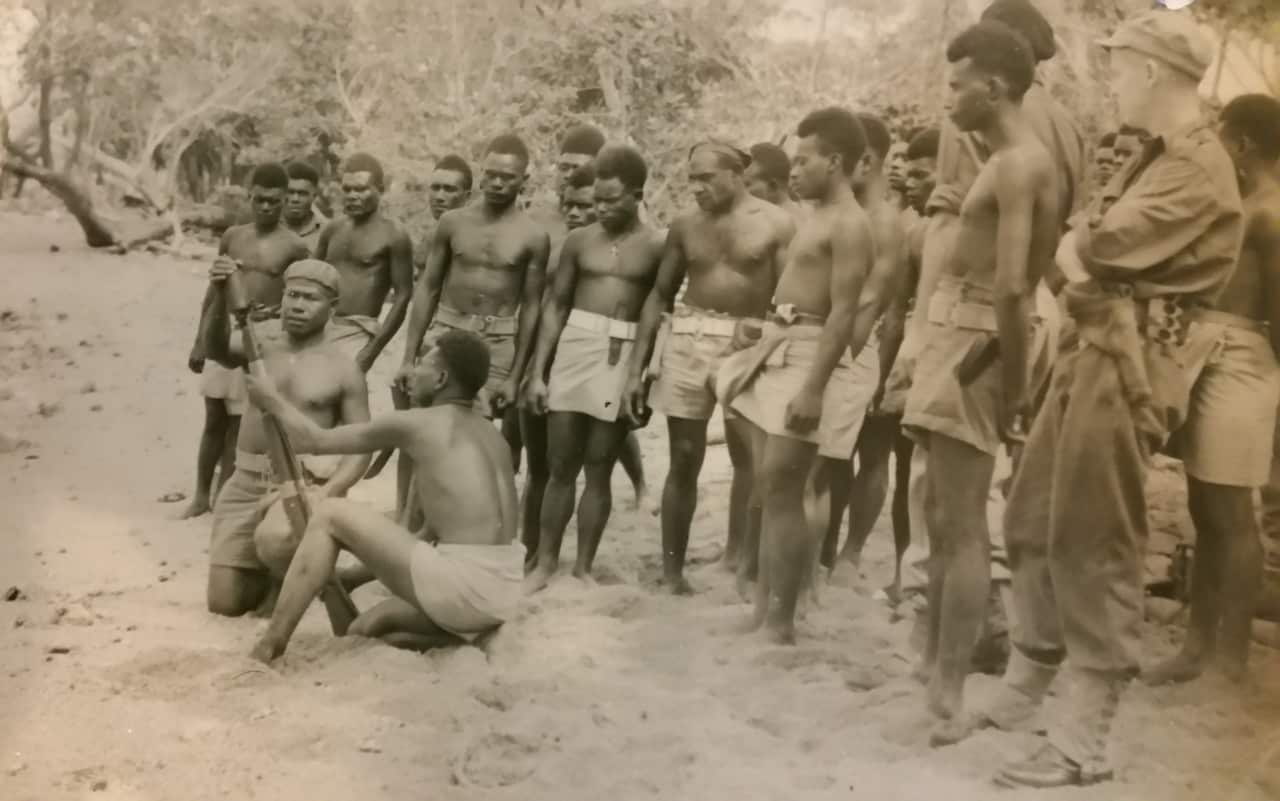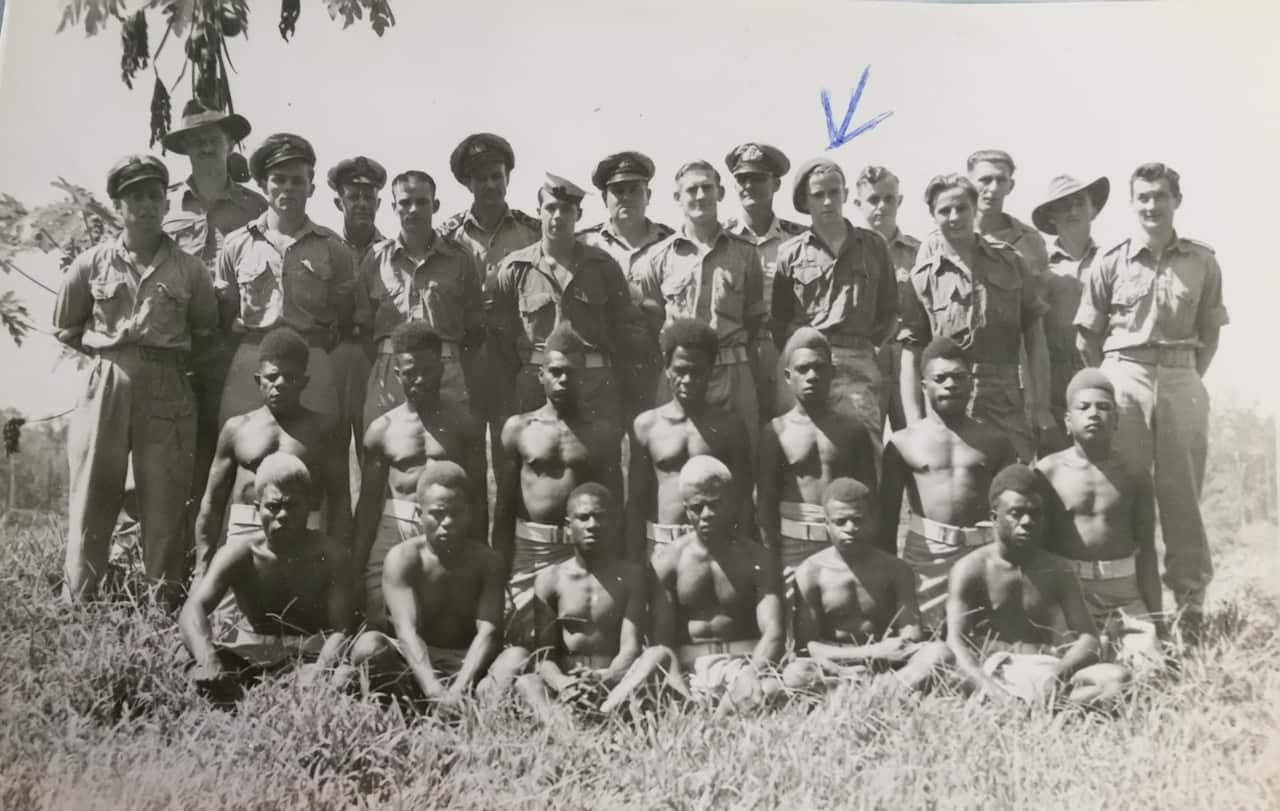One of the last survivors of a top-secret Second World War unit says he fears its efforts in the Pacific will be forgotten and is posting his story online before it is too late.
Credited with "saving the Pacific", the Australian-led coastwatchers operated behind enemy lines with Pacific Island soldiers and scouts to spy on the Japanese Imperial forces.
Dozens of coastwatchers were captured and killed, but they had many successes, including saving the life of a future president of the United States.
The codes that saved thousands of Allied lives during the Second World War's Pacific theatre are still fresh in the memory of former commando sergeant Jim Burrowes.
"Sixty bombers headed your way, two hours, 10,000 feet. Dah-dit-dah-dah-dit. I still know my Morse code,” he said.
A member of the Allied Intelligence Bureau Special M unit, Mr Burrowes kept a rare memento from the jungle, of the secret Australian mission.
"This is the Morse code key I used during the war. I pinched it and brought it home,” he said. Ahead of the Japanese invasions in the Pacific in 1942, Australian navy commander Eric Feldt trained civilians in New Guinea, Papua, the Solomon Islands and elsewhere in the South-West Pacific as radio operators.
Ahead of the Japanese invasions in the Pacific in 1942, Australian navy commander Eric Feldt trained civilians in New Guinea, Papua, the Solomon Islands and elsewhere in the South-West Pacific as radio operators.

Jim Burrowes training New Guinea troops in the use of a mortar. Source: Supplied
Commandos like Jim Burrowes were sent to reinforce and relieve them behind enemy lines as the military campaigns stretched into months of bloody fighting.
“It was so top secret that no-one but the people in it knew anything about it,” Mr Burrowes said.
“I was young, it was just high adventure, there’s no way we were heroes, we had a job to do.
“One instruction was that we were to hide in the jungle, not getting caught and not engage the enemy.”
Mr Burrowes is one of the last veterans of the operation, known as Ferdinand, and is committing his memories to a website called The Last Coastwatcher before the secrets of the war are lost.
"They have been forgotten and not just the coastwatchers, but the local people who assisted them as scouts and coastwatchers,” Pacific war historian Martin Hadlow said.
"This was a unique operation and provided invaluable strategic and tactical information back to the US naval forces, marines on Guadalcanal, and they would have a couple of hours' notice that the Japanese would bomb them. And that was vitally important."
From their jungle hideouts, the coastwatchers radioed coded messages to Supreme Commander of Allied forces in the South-West Pacific, US general Douglas MacArthur, at Allied headquarters in Brisbane.
The early warnings resulted in the Japanese advance in the Pacific being halted at Guadalcanal in the Solomon Islands in early 1943 by the US Marines.
Mr Burrowes was assigned to the mountains above the main Japanese base at Rabaul in 1943, keeping watch over tens of thousands of enemy soldiers, their planes and ships.
“To a large extent the intenseness (of battle) had been bypassed but we were always a bit concerned and wondered why they couldn’t pinpoint us,” he said.
“There certainly was no way we’d be rescued but I don’t remember being scared.”
To survived they depended totally on their Islander soldiers and scouts.
"I can't speak highly enough of the native troops we had. Without them, there would not have been any coastwatchers,” he said.
“It took 12 carriers to move our radios around and move 50 or 100 miles in the bush somewhere, they knocked up our huts, ran up the trees to put the wires up for the aerial, they fed us, they protected us, they were wonderful.” The coastwatchers' and scouts' role was also to rescue downed airmen and sailors.
The coastwatchers' and scouts' role was also to rescue downed airmen and sailors.

A group of coastwatchers and scouts (Jim Burrowes marked with an arrow). Source: Supplied
In the Solomon Islands, the Islander scouts famously saved future US president John F Kennedy when the Japanese sank his P109 patrol boat.
“(US Navy commander of the South Pacific) Admiral Bull Hallsey recognised the value of the operation to Allied forces when he said, 'The coastwatchers saved Guadalcanal, and Guadalcanal saved the Pacific,” Dr Hadlow said.
“Many of the operations remain secret to today, and I’m convinced there are lots of interesting files still in the Australian War Memorial and National Archives in Canberra.”
The coastwatchers and scouts are recognised in the Solomon Islands with the memorial that bears Admiral Hallsey’s words.
“The coastwatchers saved the Pacific war. Full stop. The Australian coastwatchers, of whom I was one,” Mr Burrowes said.
The coastwatchers and scouts will be commemorated in August in Honiara when the United States government marks the 75th anniversary of the Battle of Guadalcanal, and the Australia government marks the loss of 84 lives when HMAS Canberra, that lead the Allied invasion fleet, was sunk.
Of about 400 coastwatchers, more than 30 were captured, tortured and killed.
Mr Burrowes said he hopes, when he is gone, they will not be forgotten.
Solomon Islands targets WWII tourism market
Share



